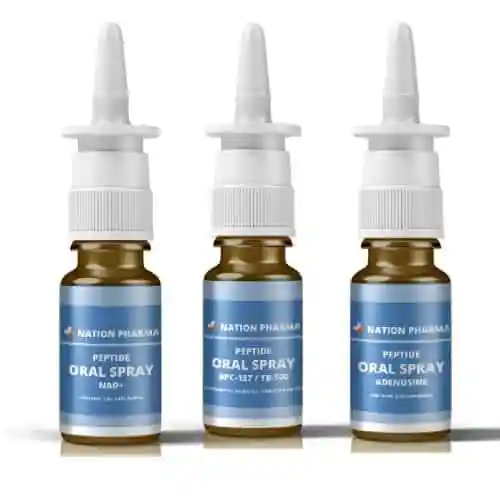Research Protocol for the Brain Body Recovery Bundle:
NAD+ – For research purposes only, 7 sprays daily.
BPC-157 / TB-500 – For research purposes only, 7 sprays daily.
Adenosine – For research purposes only, 7 sprays daily.
NAD+
Nicotinamide adenine dinucleotide (NAD) is a coenzyme central to metabolism.[3] Found in all living cells, NAD is called a dinucleotide because it consists of two nucleotides joined through their phosphate groups. One nucleotide contains an adenine nucleobase and the other, nicotinamide. NAD exists in two forms: an oxidized and reduced form, abbreviated as NAD+ and NADH (H for hydrogen), respectively.
In cellular metabolism, NAD is involved in redox reactions, carrying electrons from one reaction to another, so it is found in two forms: NAD+ is an oxidizing agent, accepting electrons from other molecules and becoming reduced; with H+, this reaction forms NADH, which can be used as a reducing agent to donate electrons. These electron transfer reactions are the main function of NAD. It is also used in other cellular processes, most notably as a substrate of enzymes in adding or removing chemical groups to or from proteins, in posttranslational modifications. Because of the importance of these functions, the enzymes involved in NAD metabolism are targets for drug discovery.
BPC-157
BPC-157 (also known as PL 14736) is a pentadecapeptide. It has the amino acid sequence Gly-Glu-Pro-Pro-Pro-Gly-Lys-Pro-Ala-Asp-Asp-Ala-Gly-Leu-Val. This peptide has a molecular formula of C62H98N16O22. The PUBCHEM ID is CID 9941957.
There are some tentative pre-clinical studies on animals and in vitro suggesting possible benefit in wound healing and bowel disorders although all of these studies come from a single research group.
TB-500
Work with cell cultures and experiments with animals have shown that administration of thymosin β4 can promote migration of cells, formation of blood vessels, maturation of stem cells, survival of various cell types and lowering of the production of pro-inflammatory cytokines. These multiple properties have provided the impetus for a worldwide series of on-going clinical trials of potential effectiveness of thymosin β4 in promoting repair of wounds in skin, cornea and heart.
Such tissue-regenerating properties of thymosin β4 may ultimately contribute to repair of human heart muscle damaged by heart disease and heart attack. In mice, administration of thymosin β4 has been shown to stimulate formation of new heart muscle cells from otherwise inactive precursor cells present in the outer lining of adult hearts, to induce migration of these cells into heart muscle and recruit new blood vessels within the muscle.
Adenosine
Adenosine (symbol A) is an organic compound that occurs widely in nature in the form of diverse derivatives. The molecule consists of an adenine attached to a ribose via a β-N9-glycosidic bond. Adenosine is one of the four nucleoside building blocks of RNA (and its derivative deoxyadenosine is a building block of DNA), which are essential for all life on earth. Its derivatives include the energy carriers adenosine mono-, di-, and triphosphate, also known as AMP/ADP/ATP. Cyclic adenosine monophosphate (cAMP) is pervasive in signal transduction. Adenosine is used as an intravenous medication for some cardiac arrhythmias.
Adenosyl (abbreviated Ado or 5′-dAdo) is the chemical group formed by removal of the 5′-hydroxy (OH) group. It is found in adenosylcobalamin (an active form of vitamin B12) and as a radical in the radical SAM enzymes.

